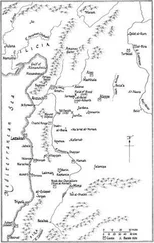The Crusaders set out from the Valley of Rephraim, which faces Calvary; they advanced towards the north, and saluted, on entering into the Valley of Jehoshaphat, the tombs of Mary, St. Stephen, and the first elect of God . On continuing their march towards the Mount of Olives, they contemplated with much respect the grotto in which Christ sweated blood, and the spot where the Saviour wept over Jerusalem. When they arrived at the summit of the mountain, the most imposing spectacle presented itself to their eyes. Towards the east were the plains of Jericho, the shores of the Dead Sea and the Jordan; and to the west they saw at their feet the holy city and its territory, covered with sacred ruins. Assembled on the very spot whence Christ ascended into heaven, and where they still sought for the vestiges of his steps, they listened to the exhortations of the priests and bishops.
Arnold de Rohés, chaplain to the duke of Normandy, addressed them in a pathetic discourse, conjuring them to redouble their zeal and perseverance. When terminating his discourse, he turned towards Jerusalem: “You see,” said he to them, “the heritage of Christ trampled underfoot by the impious; here is, at last, the worthy reward of all your labours; here are the places in which God will pardon all your sins, and will bless all your victories.” At the voice of the orator, who pointed out to them the church of the Resurrection and the rocks of Calvary, ready to receive them, the defenders of the cross humbled themselves before God, and kept their eyes fixed upon Jerusalem.
As Arnold exhorted them, in the name of Christ, to forget all injuries, and to love one another, Tancred and Raymond, who had had long and serious disputes, embraced each other in the presence of the whole Christian army. The soldiers and leaders followed their example. The most rich promised to comfort the poor by their alms, and to support the orphans of the bearers of the cross. All forgot their fatal discords, and swore to remain faithful to the precepts of evangelical charity.
Whilst the Crusaders were thus giving themselves up to transports of devotion and piety, the Saracens assembled on the ramparts of Jerusalem, raised crosses high in the air, and treated them with all kinds of outrages, at the same time insulting the ceremonies of the Christians by their gestures and their clamours. [167]“You hear them,” said Peter the Hermit; “you hear the menaces and the blasphemies against the true God; swear to defend Jesus Christ, a prisoner, and crucified a second time by the infidels. You see him who expires afresh upon Calvary for the redemption of your sins.” [168]At these words the cenobite was interrupted by the groans and cries of indignation which arose on all parts against the infidels. “Yes, I swear by your piety,” continued the orator, “I swear by your arms, that the reign of the impious is near its end. The army of the Lord has only to appear, and all that vain mass of Mussulmans will disperse like a shadow. To-day they are full of pride and insolence, to-morrow they shall be frozen with fear, and shall fall motionless before you, like the guardians of the sepulchre, who felt their arms escape from their hands, and fell dead with fright, when an earthquake announced the presence of a God on that Calvary on which you are going to mount the breach. Still a few moments, and these towers, the last bulwark of the infidels, shall be the asylum of the Christians; these mosques, which stand upon Christian ruins, shall serve as temples for the true God, and Jerusalem shall only henceforward hear the praises of the Lord.”
At these last words of Peter the most lively transports broke forth among the Christians; they embraced, shedding tears, and exhorting each other to support the evils and the fatigues of which they should so soon receive the glorious reward. The Christians at length descended the Mount of Olives to return to their camp, and, taking their route southward, they saluted on their right the tomb of David, and passed close to the pool of Siloë, where Christ restored sight to the man born blind. They perceived, further on, the ruins of the palaces of Judah, and marched along the declivity of Mount Sion, where other remembrances arose before them to add to their enthusiasm. Towards evening, the Christian army returned to their quarters, repeating these words of the prophet: The nations of the West shall fear the Lord; and the nations of the East shall see his glory. When they had regained their camp, the greater part of the pilgrims passed the night in prayer; the leaders and the soldiers confessed their sins at the feet of their priests, and received their God, whose promises filled them with confidence and hope.
Whilst these things were passing in the Christian camp, the most profound silence reigned over the walls of Jerusalem; nothing was heard but the voices of the men who, from hour to hour, from the tops of the mosques of the city, called the Mussulmans to prayer. The infidels came in crowds to their temples to implore the protection of their prophet, and swore by the mysterious stone of Jacob to defend a city which they called the House of God . The besieged and the besiegers were stimulated by an equal ardour to fight and to shed their blood, the former to preserve, and the latter to conquer a city which both held sacred. The hatred which animated them was so violent, that during the whole siege no Mussulman deputy came into the Christian camp, nor did the Christians deign to summon the garrison to surrender. Between such enemies the shock must necessarily be terrible, and the victory implacable.
The leaders of the Christian army being assembled to decide upon the day for attacking the city, it was resolved to take advantage of the enthusiasm of the pilgrims, which was at its height, and to press forward the assault, the preparations for which were rapidly going on. As the Saracens had raised a great number of machines on the sides of the city most threatened by the Christians, it was agreed that they should change the dispositions of the siege, and that the principal attack should be directed towards the points where the enemy had made the least preparations for defence.
During the night Godfrey removed his quarters eastward, near to the gate of Cedar, and not far from the valley in which Titus was encamped when his soldiers penetrated into the galleries of the temple. The rolling tower, and the other machines of war which the duke of Lorraine had caused to be constructed, were transported with incredible difficulty in face of the walls he intended to attack. Tancred and the two Roberts got ready their machines, between the gate of Damascus and the angular tower, which was afterwards called the tower of Tancred . [169]
When the Saracens, at daybreak, saw these new dispositions, they were seized with astonishment and affright. The Crusaders might have taken profitable advantage of the alarm which this change created in the enemy, but upon steep ground it was difficult to bring the towers up close to the walls. Raymond in particular, who was charged with the attack on the south, found himself separated from the rampart by a ravine, which it was necessary to have filled up. He immediately made it known, by a herald-at-arms, that he would pay a denier to every person who should cast three stones into it. A crowd of people instantly flew to second the efforts of his soldiers; nor could the darts and arrows, which were hurled like hail from the ramparts, at all relax the ardour and zeal of the assailants. At length, at the end of the third day, all was finished, and the leaders gave the signal for a general attack.
On Thursday, the 14th of July, 1099, as soon as day appeared, the clarions sounded in the camp of the Christians; all the Crusaders flew to arms; all the machines were in motion at once; the stone-machines and mangonels vomited showers of flints, whilst under the cover of tortoises and galleries, the rams were brought close to the walls. The archers and cross-bowmen kept up a continual discharge against the rampart; whilst the most brave planted their ladders in places where the wall seemed to offer least resistance. On the north, east, and south of the city, the three towers advanced towards the ramparts, amidst the tumult and shouts of the soldiers and the workmen. Godfrey appeared on the highest platform of his wooden fortress, accompanied by his brother Eustace and Baldwin du Bourg. He animated his people by his example; and every javelin that he cast, say the historians of the times, carried death among the Saracen host. Raymond, Tancred, the duke of Normandy, and the count of Flanders fought amidst their soldiers; whilst the knights and men-at-arms, animated by the same zeal as their principal chiefs, flew from place to place where danger called them.
Читать дальше












